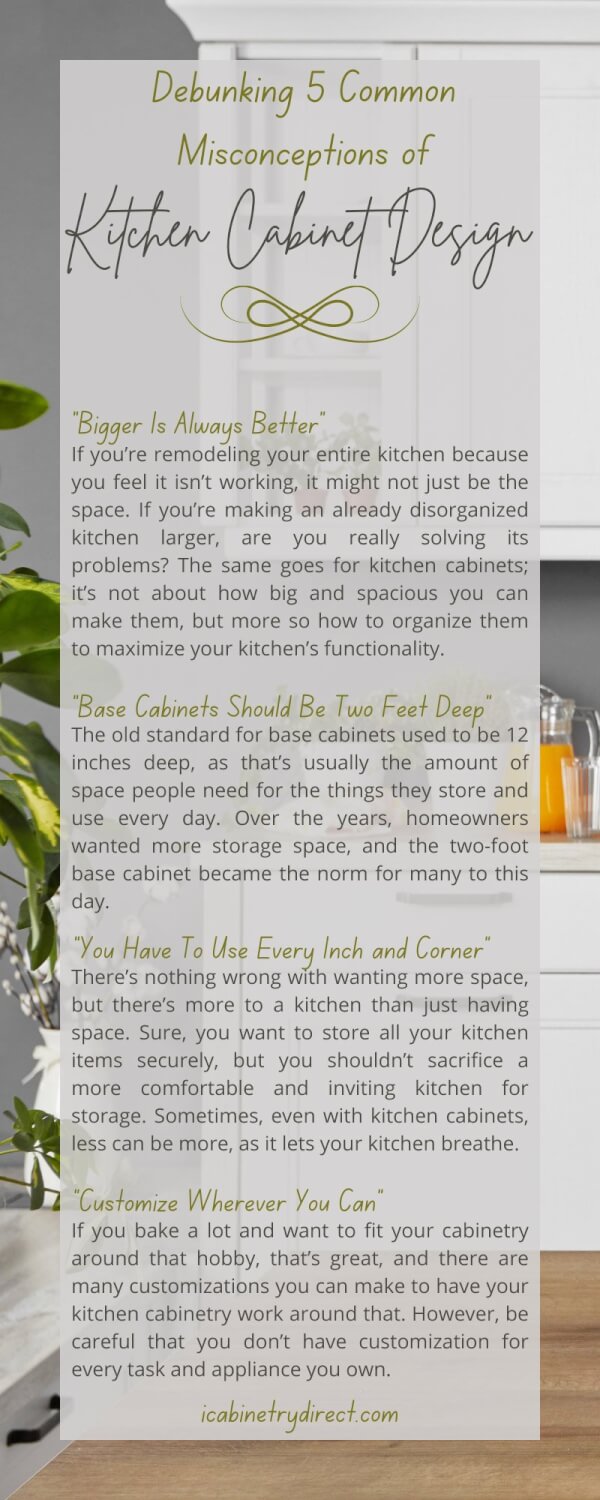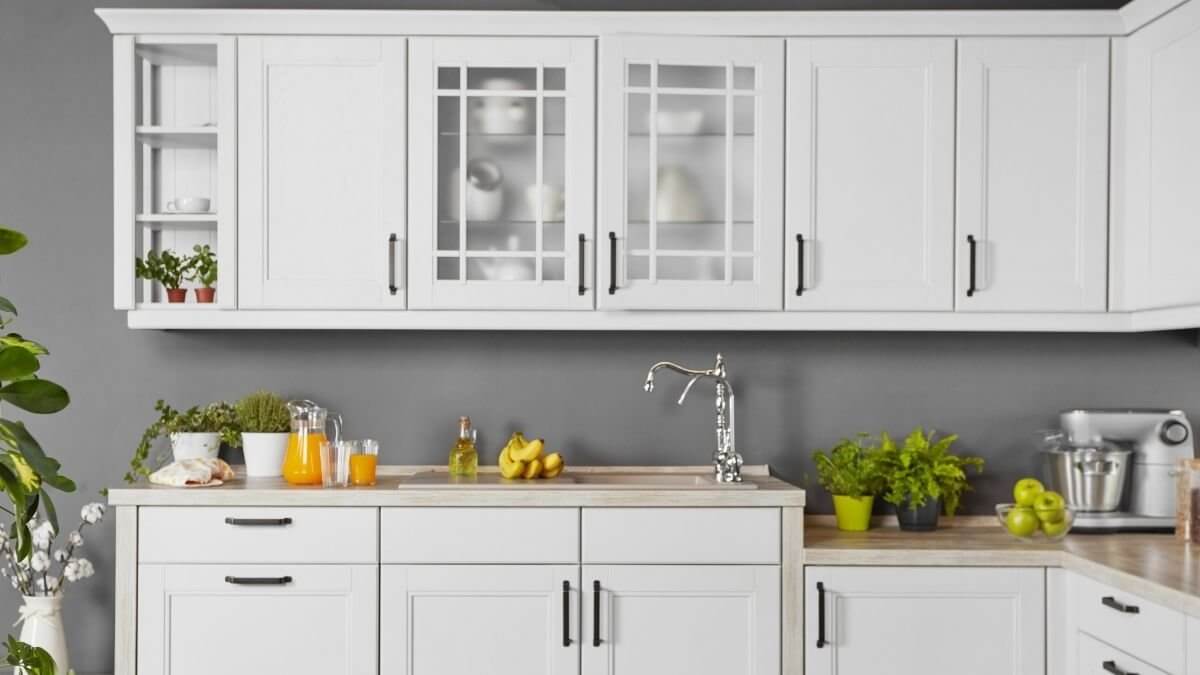When you deal with kitchen cabinets and design all day, you encounter many myths that people mistakenly believe are the rules. Something worked for one designer and told everyone they should do it, even though it might not suit everyone. We want to help dispel these notions by debunking five common misconceptions of kitchen cabinet design. Don’t be caught making these simple but common mistakes.
“Bigger Is Always Better”
Whether you’re replacing old kitchen cabinets, remodeling your entire kitchen, or designing a new kitchen for a new home, you probably think you want to focus on maximizing the space you have. No one wants a cramped kitchen, and bigger is always better, right? Not always.
If you’re remodeling your entire kitchen because you feel it isn’t working, it might not just be the space. If you’re making an already disorganized kitchen larger, are you really solving its problems? The same goes for kitchen cabinets; it’s not about how big and spacious you can make them, but more so how to organize them to maximize your kitchen’s functionality.
“Base Cabinets Should Be Two Feet Deep”
The old standard for base cabinets used to be 12 inches deep, as that’s usually the amount of space people need for the things they store and use every day. Over the years, homeowners wanted more storage space, and the two-foot base cabinet became the norm for many to this day.
However, the recent trend of larger and more functional kitchen islands has made many of the two-foot-deep base cabinets unnecessary. If you have a kitchen island that offers plenty of storage space, you likely don’t need two-foot-deep cabinets. Instead, opt for the 12-inch cabinets to save space in your kitchen you can use elsewhere.
At iCabinetry, you can get custom Starmark inset cabinets detailed to your exact specifications—from their style to their size and finish!
“You Have To Use Every Inch and Corner”
“Bigger is better” isn’t the only misguided mentality—so is the obsession many homeowners and designers have with maximizing every inch within their kitchen layout and cabinets. There’s nothing wrong with wanting more space, but there’s more to a kitchen than just having space. Sure, you want to store all your kitchen items securely, but you shouldn’t sacrifice a more comfortable and inviting kitchen for storage. Sometimes, even with kitchen cabinets, less can be more, as it lets your kitchen breathe.
You Don’t Need a Filler
When your kitchen design and cabinetry focus is only on making it bigger and maximizing your storage space, you run into problems. The filler, for example, presents a problem for many kitchens. A filler is when designers use finished wood to fill the gaps between cabinets. Some designers can’t help but see that they have, say, fifteen inches leftover and think, “I can squeeze a fifteen-inch cabinet there.”
Believe us; there’s nothing wrong with filler. To some, it’s like accepting defeat, but that’s not the case. A filler isn’t just filling in openings that aren’t big enough for a regular cabinet and door; they’re also for fixing imperfections. Don’t spend time, energy, and money trying to scheme an extra cabinet that, in all likelihood, you don’t need and would be difficult to use anyway.
Kitchen Corners Require a Lazy Susan
Like filler cabinets, the corner for many kitchens in an L-shaped or even U-shaped layout leaves an awkward corner cabinet. The standard solution for many designers is the Lazy Susan. It’s a reasonable solution, as a Lazy Susan makes the awkward space productive, and many homeowners prefer using them to traditional cabinets.
However, the Lazy Susan in the corner cabinet is not a kitchen design law we all must follow. An alternative is a blind cabinet, which can fit in the corner but is blind to the naked eye. Half of a blind cabinet is hidden, so you have to reach pretty deep inside to grab pots, pans, or whatever you have stored there.
A blind cabinet gives you the added storage for items you rarely use, but without the mechanical requirements and expenses of a Lazy Susan. In some instances, cabinets must be custom-fitted to fit a Lazy Susan in the corner because designers think every kitchen must have one. Having a blind cabinet instead is an excellent way to trim your budget and retain most of the functionality of your kitchen and cabinets.
“Customize Wherever You Can”
We get it, it’s your kitchen, and you want everything customized to your needs. There’s nothing wrong with personalization, as your kitchen and cabinets should reflect your lifestyle, but there’s no need to go overboard with a customized cabinet for every individual appliance or task.
If you bake a lot and want to fit your cabinetry around that hobby, that’s great, and there are many customizations you can make to have your kitchen cabinetry work around that. However, be careful that you don’t have customization for every task and appliance you own.
More times than not, you’ll find you don’t use that appliance enough, or perhaps you won’t bake enough to make the customization worth it. Like all things in life, customization is better in moderation.
“You Can Make Any Cabinet Door Handle-Free”
As modern kitchen designs have become popular, the handle-free cabinet door has become trendy for many kitchen designers. The minimalist look gives your cabinets clean lines and doesn’t distract with knobs or handles. Before you decide to go without handles, consider that not every door is built for that function.
Cabinet doors manufactured to be without handles are cut in a specific way to give it a handy groove at the top or bottom of the door. This groove provides you with something to grip instead of a handle. But not every cabinet door is cut this way, so if you remove the knobs or handles, it won’t be as easy to grip.
At first, you might think that it’s not a big deal, and that you’ll still be able to grip the cabinet door without the groove. But after a few days and weeks of your hand slipping on the cabinet door, you’ll be searching for handles or knobs to throw on those cabinets. Research your cabinet doors first before you decide to go handle-free.
There are a lot of myths surrounding kitchen design out there, and we hope we’ve helped debunk five common misconceptions about kitchen cabinet design for you. There may be a lot of designs and trends that work for others but don’t quite fit with what you want for your kitchen. Be sure to research, and don’t hesitate to reach out to the pros at iCabinetry with any questions you have about kitchen cabinets and design!





